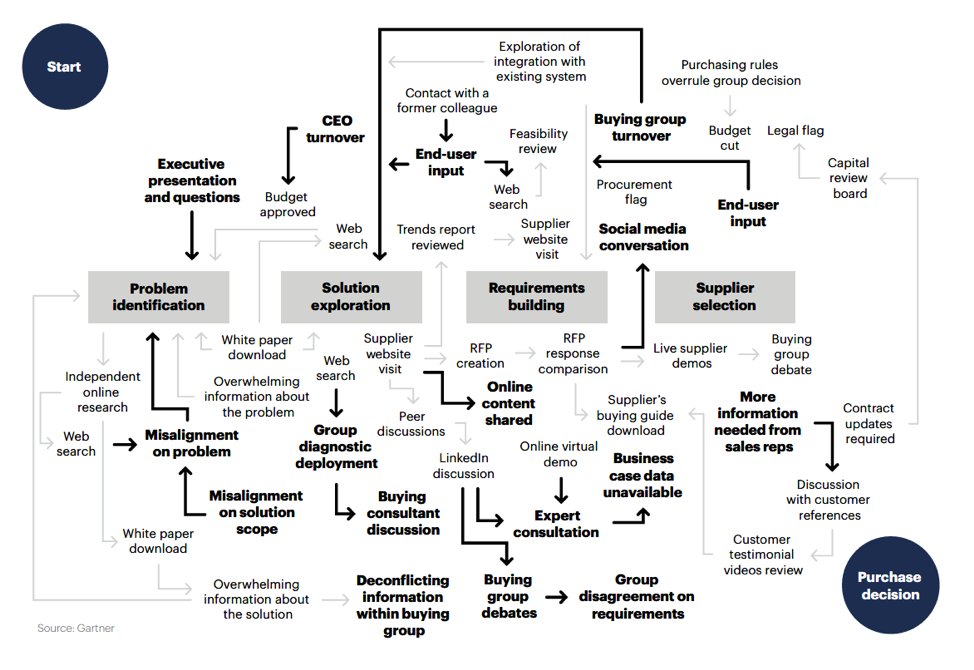 The B2B buyer’s journey is a nonlinear process. But sellers still track deals using discrete stages in a linear sales process. This disconnect compromises pipeline analytics and sales forecasts, leaving sales managers without good information to identify risk in their sellers’ deals.
The B2B buyer’s journey is a nonlinear process. But sellers still track deals using discrete stages in a linear sales process. This disconnect compromises pipeline analytics and sales forecasts, leaving sales managers without good information to identify risk in their sellers’ deals.
Gartner research indicates that B2B buyers execute six distinct jobs — problem identification, solution exploration, requirements building, supplier selection, validation and consensus creation — to successfully complete a purchase. Often, however, they will revisit these jobs at least once before making a purchase, resulting in a buying journey that resembles more of a maze than a linear path. With easy access to a wealth of quality information, B2B buyers are engaging with sellers less frequently, and they often revisit buying tasks that were traditionally executed chronologically.

This leaves sales managers unable to proactively identify stalled deals and unable to prescribe helpful solutions to help their sellers face these issues. Sales leaders must take four steps to overcome this disconnect.
Step 1: Introduce a better measure of deal progress
Given the complexity of today’s B2B buyer journeys, sales stage offers limited value as a measure of opportunity progress. The best way is through tracking customer verifiers — objectively verifiable outcomes — for each job in the buyer’s process. This will increase pipeline quality and give sellers a standard method for assessing their opportunities that is more precise than a sales process with artificially imposed linear sales stages.
Step 2: Automate opportunity scoring
To align opportunity management more closely with the buyer’s journey, introduce verifier-based opportunity scoring that can coexist with the linear sales process common in existing customer relationship management/sales force automation (CRM/SFA) systems.
A phased rollout of verifier-based pipeline management and analytics enables a selling organization to evolve from a CRM/SFA based on a traditional linear sales process to one that assesses pipelines with consideration for the actual buyer’s journey.
Step 3: Incorporate opportunity scoring into forecast analytics
Opportunity scoring based on customer verifier completion and buyer job revisits offers a more accurate method for quantifying pipeline value. Add insight into pipeline analytics by weighing opportunity values based on buyer job completion. This approach not only increases the insight of existing pipeline analytics, but it also helps lay the foundation for artificial intelligence (AI) forecasting.
As organizations adopt AI-enabled solutions, predictive analytics can be developed from historical pipelines with customer verifier tracking and opportunity scores. AI-based forecasting can use this data to project revenue for the current period, and the accuracy of that projection will increase with more accumulated data.
Step 4: Build analytics based on buyer job progress
Beyond sales forecasting, sales managers rely on pipeline analytics for two important purposes: To assess the health of their pipeline and to diagnose areas where their sellers need coaching. Tracking customer verifiers unlocks new metrics and insights that help sales managers achieve both of these goals:
- Verifier cycle time: A metric that indicates the average time spent on each verifier.
- Verifier velocity: A metric used to measure seller effectiveness at the customer verifier level.
- Verifier status mix: A metric used to assess seller and team pipeline health.
These metrics enable sales organizations to identify opportunity risk and areas of seller need. This, in turn, provides sales teams with the insight they need to improve their efficiency and effectiveness.
Steve Rietberg is a Senior Director Analyst in Gartner’s Sales practice, focusing on sales analytics, sales systems, sales methodology and sales force design.







